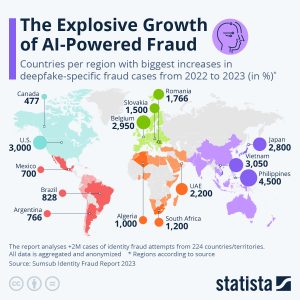In the vast landscape of the internet, where connections span the globe and information flows ceaselessly, there exists both the incredible promise of knowledge and the lurking threat of deception. Exploiting the digital landscape’s expansiveness, scammers employ sophisticated methods to target unsuspecting individuals, aiming to capitalize on vulnerabilities for their own benefit. Yet, in this digital arena, a new contender has arisen – Artificial Intelligence (AI) pitted against itself, serving as a guardian against online scams.
“2023 showed 46% of respondents being most concerned about the ‘advance of adversarial capabilities – phishing, malware development, deepfakes’ in terms of the risks artificial intelligence poses for cybersecurity in the future”. World Economic Forum
The Rise of AI Use in Online Scams
The rise of AI in combatting online scams is mirrored by its increasing utilization by malicious actors. Scammers, recognizing the potential of AI to automate and optimize their fraudulent activities, have begun incorporating machine learning algorithms into their schemes to craft AI scams. From personalized phishing emails generated by natural language processing models to sophisticated chatbots capable of engaging in convincing social engineering tactics, AI has become a double-edged sword in the world of cybercrime. This trend highlights the need for continual innovation and adaptation in the fight against online scams, as defenders must stay ahead of the curve to counter the evolving tactics of tech-savvy fraudsters.

The Rise of AI in Combatting Online Scams
As technology advances, so does the sophistication of tools used by scammers. From deceptive phishing emails and fraudulent websites to elaborate social engineering tactics, malicious actors continually adapt, presenting a formidable challenge to cybersecurity experts and internet users. In response to this evolving threat landscape, the utilization of AI has surged, highlighting its versatility in combatting online scams. AI-powered systems employ machine learning algorithms to detect patterns indicative of fraudulent activities, enabling quicker identification and mitigation of risks. One significant application of AI in this domain is web content filtering, where algorithms sift through vast volumes of online content in real-time to identify and block malicious websites and phishing attempts. By analyzing patterns, keywords, and other indicators of suspicious activity, web content filtering acts as a proactive safeguard, protecting users from falling victim to scams. Additionally, AI is utilized in data analysis to uncover emerging trends and tactics employed by scammers, aiding in the development of more robust cybersecurity strategies.
“77% of victims said they had lost money as a result of AI voice scams.” McAfree
Online Scams Need Collaborative Action
Effective collaboration stands as the cornerstone in the battle against online scams. Together, stakeholders can achieve remarkable outcomes through:
- Information Sharing: By pooling resources and intelligence, stakeholders such as law enforcement agencies, tech firms, and financial institutions enhance their capacity to track and apprehend scammers. Collaborative efforts unveil patterns and trends that might otherwise elude detection.
- Amplified Public Awareness: A united front enables the creation of impactful public awareness campaigns. These campaigns, crafted through collective expertise, educate individuals on prevalent scams, warning signs, and strategies for safeguarding themselves online.
- Legislative Action: Governments, with input from industry experts and consumer protection advocates, can craft and enact targeted legislation to combat online scams. Collaboration ensures that these measures are comprehensive and effectively address evolving threats.
- Streamlined Reporting and Response: Establishing a centralized platform for reporting scams facilitates data collection and analysis. This shared repository empowers authorities to respond swiftly and decisively to emerging threats.
- Technological Advancements: Collaboration among tech companies fosters the development and dissemination of cutting-edge tools and technologies. These innovations bolster the effectiveness of anti-scam mechanisms, enhancing protection for users across digital platforms.
Leveraging Netsweeper in Collaborative Action Against Scams
Netsweeper plays a crucial role in fostering collaborative efforts to combat online scams. Through its centralized platform and innovative filtering capabilities, Netsweeper offers a secure environment for various stakeholders – individuals, government agencies, law enforcement, tech firms, and financial institutions – to convene and collaborate. By facilitating seamless data sharing and intelligence exchange in real-time, Netsweeper empowers a unified approach against online scams. This collaborative framework not only bolsters digital defenses but also enables stakeholders to jointly strategize and respond swiftly to the ever-changing landscape of online threats.
Challenges and Future Directions
Looking ahead, the future of AI in combatting online scams holds great promise, with advancements in machine learning, natural language processing, and pattern recognition poised to enhance detection capabilities against even the most sophisticated fraudulent behaviors. Moreover, collaboration among cybersecurity experts, tech firms, and law enforcement agencies will be pivotal in navigating the ever-evolving threat landscape. As AI confronts AI in the realm of online scams, users can traverse the digital landscape with heightened assurance, knowing that robust AI algorithms are tirelessly working to safeguard against harm. As technology progresses, the ongoing refinement of defenses promises a safer and more secure online experience for all.
